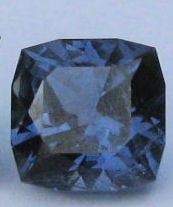JewelFreak
Ideal_Rock
- Joined
- Sep 3, 2009
- Messages
- 7,768
Last week when I picked up my watch after cleaning at a local jeweler, I took along a blue spinel to get a baseline B&M setting price for comparison w/online vendors. This guy is very good & very nice; spent a good hour playing around w/his stuff & admiring designs he did for clients. But under his microscope, a horsetail showed up that is not visible at all w/a 10X loupe -- knowing it's there, I can see it vaguely w/my 40X LED loupe. It's a cushion, but for description's sake, the inclusion starts at about 11:00 & extends almost all the way down one side under the crown, kind of equidistant between girdle & edge facet of the table. At one end it comes up near the surface.
This jeweler said anyone who set it would do so "at your risk only." Hard for anyone to evaluate w/out photos, but I'm wondering about setting it. Is it a very iffy proposition with something like that? Was thinking about halo-ing it. Pic of the spinel below, sorry I couldn't get one under the jeweler's microscope. Thanks for your input!
--- Laurie

This jeweler said anyone who set it would do so "at your risk only." Hard for anyone to evaluate w/out photos, but I'm wondering about setting it. Is it a very iffy proposition with something like that? Was thinking about halo-ing it. Pic of the spinel below, sorry I couldn't get one under the jeweler's microscope. Thanks for your input!
--- Laurie




300x240.png)